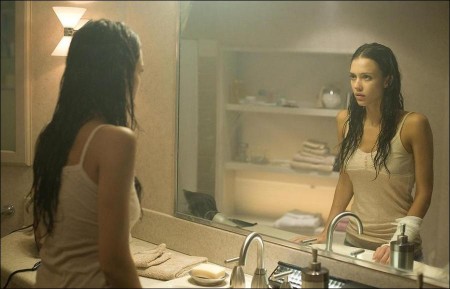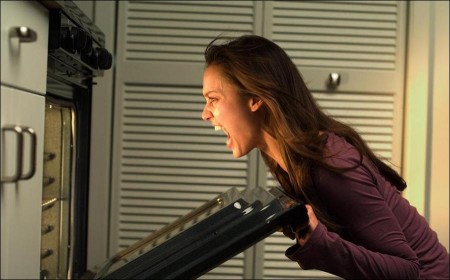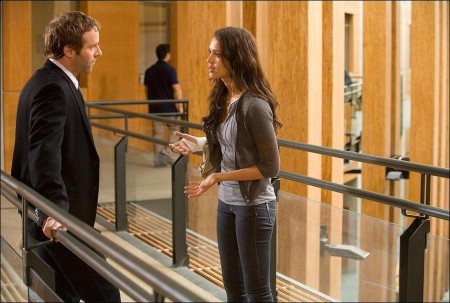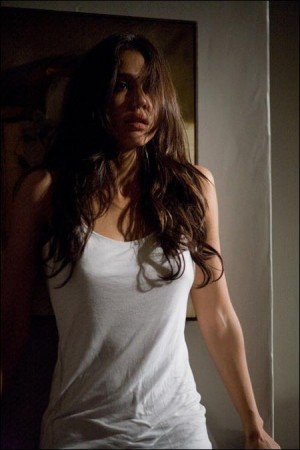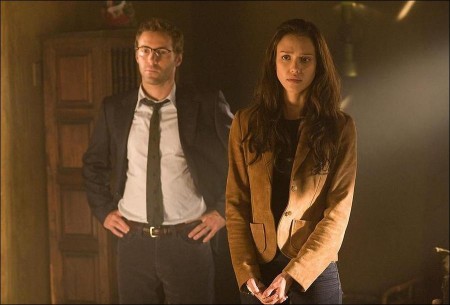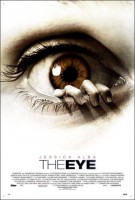Tagline: How can you believe your eyes when they’re not yours?
“The Eye” is a thriller about a cornea transplant recipient who sees disturbing images in the mirror that send her on a quest to find out what happened to the eye’s previous owner. The original was made in Hong Kong by Thai directing brothers Danny and Oxide Pang.
Sydney Wells (Jessica Alba) is an accomplished, independent, Los Angeles-based concert violinist. She is also blind, and has been so since a childhood tragedy. As our story opens, Sydney undergoes a double corneal transplant, a surgery she has waited her whole life to have, and her sight is restored. After the surgery, neural ophthalmologist Dr. Paul Faulkner (Alessandro Nivola) helps Sydney with the difficult adjustment, and with the support of her older sister Helen (Parker Posey), Sydney learns to see again.
But Sydney’s happiness is short-lived as unexplainable shadowy and frightening images start to haunt her. Are they a passing aftermath of her surgery, Sydney’s mind adjusting to sight, a product of her imagination, or something horrifyingly real? As Sydney’s family and friends begin to doubt her sanity, Sydney is soon convinced that her anonymous eye donor has somehow opened the door to a terrifying world only she can now see.
About the Production
How do we judge what is real? Can our eyes be trusted to not mislead, to show things as they are? How do we know that what we are seeing is really there? Over 30,000 Americans undergo corneal transplants each year, and is quickly becoming commonplace procedure. But, what would happen if something unforeseen occurred? THE EYE portrays the terrifying events that befall a young woman, Sydney Wells, who undergoes such a procedure, but she soon discovers her new eyes bring with them far more than she ever expected.
Sydney Wells, the protagonist in THE EYE, is not your typical movie heroine. Blinded in both eyes after a tragic childhood accident, she’s beautiful, confident, and, despite her disability, has managed to achieve a happy, fulfilling life as a successful concert violinist in Los Angeles. At the urging of her sister, Sydney elects to undergo a double corneal transplant in the hopes of regaining her sight. This life-changing surgery catapults her into a nightmarish odyssey that challenges her most fundamental notions of sanity, identity and perception. Is she experiencing the phenomena of cellular memory, or it something far worse that exceeds the limits of the imagination? For Jessica Alba, the stunning star of such hits as SIN CITY and the FANTASTIC FOUR movies, tackling the role of Sydney offered a unique and exciting opportunity to stretch as an actor and delve into a rich, multi-faceted character.
“Sydney is a challenging part that required a lot of preparation,” says Alba. “I was really looking for the right thriller / horror movie to do, and most of them are slasher, gore-for-gore’s sake and vulgar. But THE EYE is very classy, elegant and beautifully written, and Sydney is such a unique, interesting person. Her journey, the process of regaining her sight and then everything that she faces afterwards, it really intrigued me.”
From Lionsgate and Paramount Vantage, THE EYE is based on the 2002 Asian horror film of the same name written by Jo Jo Yuet-chun Hui, Oxide Pang and Danny Pang and directed by the Chinese filmmaking duo Danny Pang and Oxide Pang. The film, which was an international hit, caught the attention of C/W Productions, who bought the rights for an American remake. “Great films have at their core characters who are trying to achieve something on either a physical or emotional level,” states Paula Wagner. “Alba’s character Sydney overcomes her physical disability,” continues Wagner, “and following cornea transplant she learns that she must rediscover who she is and her place in the world and must learn to handle the emotional changes that come with it.”
Executive Producer Michael Paseornek commented, “The original Asian film is a favorite among critics and horror fans alike. We are excited to be re-inventing this smart thriller with Jessica — our second film with her in a year — as well as with the very respected and creative filmmaker Paula Wager, Don Granger and her team at C/W. Our directors Xavier and David will deliver what we are sure will be an edge-of-your-seat thriller.” In developing the script, C/W producer Don Granger worked closely with screenwriter Sebastian Gutierrez, saying that “there is a fine line when re-interpreting a film that has already garnered international success. It is a constant challenge to improve upon the original source and maintain the integrity of the story.”
While THE EYE is propelled by supernatural elements, the film’s plot hinges on an actual scientific phenomenon known as cellular memory. Explains executive producer Darren Miller, “People who undergo organ transplants have been known to take on behaviors of the individual from whom they received the organ.”
Adds Wagner, “Someone may receive the organ of a smoker, and consequently, they suddenly get this odd desire to smoke. Or, they find themselves strangely being drawn to sports, only to discover their donor was a sports fanatic. Of course, THE EYE is fictional, but explores the real life phenomena and takes it into the supernatural.”
In the search for a director for the project, the producers approached French directing duo David Moreau and Xavier Palud, who gained international acclaim for ILS (THEM), a taut thriller they wrote and directed about a young couple who is terrorized by unseen forces in the French countryside. Of the many horror projects Moreau and Palud were subsequently offered, THE EYE was their favorite. “What we liked was the fact that we could really work on what was not obviously supernatural,” explains Moreau. “There were great opportunities to play with the audience’s minds, to show them things that they couldn’t determine were real.”
Moreau and Palud were intent on maintaining the ambiguity of Sydney’s sanity. Sydney is convinced that the dark and terrifying visions she sees following her operation are real, but her doctor and her sister can’t help but conclude that she’s undergoing a psychological breakdown. Says Alba, “This story is scary in a different way because the audience is never sure if my character really is seeing things or if she’s just losing her mind. Walking that line allows the audience to really put themselves in Sydney’s shoes.”
“I think it’s the unseen that’s always more scary,” adds Moreau. “It’s all about finding the right balance between showing and not showing, and letting the audience use their imagination.”
The French directors clearly remember the moment they first met Alba. “She came in the room and we were both so impressed with her eyes,” Moreau says. “Physically, She was exactly how we pictured Sydney.” On set, the directors were thrilled with Alba’s talent and preparedness. “Every day on the set she surprised us with her commitment to the character,” recalls Moreau. “She was always on the same track as we were.”
Faced with the daunting task of convincing audiences that Sydney is both blind and a violin virtuoso, Alba began preparing for her role four months in advance of the shoot. “The fact that I play a classical violinist was not why I did the movie,” laughs Alba. “It was definitely an interesting thing I had to tackle.” Adds Wagner, “Jessica Alba is a gifted actress who commits to the role and stays committed throughout the process with great integrity. She is a consummate professional and plays the character with subtlety, grace, and authenticity, and it’s really quite an impressive performance.”
The script called for Sydney to play a number of scenes in which her violin skills had to be shown onscreen. The directors were resolute about showing Jessica actually playing the violin, rather than miming the musical performances. “I started taking violin lessons while I was shooting the second FANTASTIC FOUR movie,” says Alba. “I had to train for months just to learn how to hold the bow and violin properly and that’s only half the battle. I’m playing complicated classical pieces in the film, so I had to learn how to actually play the notes.”
“The violin is one of the most difficult instruments to play,” adds Moreau, who has a musical background and plays the piano. “Every violinist will tell you that if you stop practicing for two days, you have to work for months to get it back. Luckily for us, Jessica was a really good student.”
Equally challenging for Alba was playing a woman who is blind. She spent time living at the New Mexico Commission for the Blind (NMCB), and received training under the guidance of a certified orientation mobility instructor. Greg Trapp, the executive director of the NMCB, explains, “She went through the program just like anyone else might who has lost their vision. The staff helped her gain the confidence to play a blind person convincingly, which is an essential part of the character.”
Impressed with the script and the character of Sydney Wells, Trapp and his staff consulted on many details concerning Sydney’s blindness and also provided many props, such as a Braille embosser and a note-taking device, which are commonly found in a blind person’s home. Trapp and his staff particularly appreciated the production’s honest portrayal of a blind woman. Explains Trapp, “What we like about Sydney is the fact that she’s an individual who’s competent, capable, articulate – in all ways normal who just so happens to be blind.”
Alba was particularly inspired by the time she spent with a young female musician who has been blind since childhood. “I hung out with her and picked up on how she interacts with people, how she gets around in the world, walks down a street, figures out her landscape and moves around with such ease.” The experience, Alba admits, corrected a lot of misconceptions she had about being blind. “Most people, including myself, are ignorant of what it really means to be blind,” she says. “I had a lot of notions of what it would be like and this woman threw that out the window. She co-exists with sighted people, competes with sighted people for jobs, and she gets them.”
“Sydney’s a very, very strong character, and we wanted audiences to see and feel that in the movie,” adds Moreau. “We never wanted to portray her as weak or helpless. Jessica trained particularly hard to make her as real and human as possible.”
For the role of Dr. Paul Faulkner, a neural specialist who helps Sydney with her transition into the sighted world, the filmmakers turned to Alessandro Nivola (FACE/OFF, LAUREL CANYON, JUNEBUG). “Dr. Faulkner gets very involved in the case because Sydney’s condition is highly unusual,” says Nivola. “He’s a very scientifically oriented person, entirely skeptical about there being any kind of supernatural reality, so he really supports the possibility that it’s just a psychological phenomenon she’s experiencing.”
Nivola, who was a fan of Moreau’s and Palud’s first film, was excited by the strain of realism that the directors brought to THE EYE. “In these movies where the primary objective is to scare the audience, it’s such an added bonus if you can create a real relationship between the characters on top of the thrill factor,” he says.
“We can rave about Alessandro for hours,” reports Moreau. “Like Jessica, Alessandro’s first love is the script. He really worked on turning what was a typical doctor into a really original, smart character. He came up with a lot of ideas that added depth to the role.”
Adds Wagner, “Alessandro brings a wonderful boyish charm to what is an otherwise serious role. You really get a sense that he became his character.”
Like Alba, Nivola spent weeks researching, acquainting himself with neural psychology and the details of his on-screen profession. “The research period of a movie has always been arguably the most exciting part of the process for me,” admits Nivola. “Having the chance to play people who have special knowledge of certain fields that I know nothing about has always seemed to me an opportunity to educate myself about something or have an experience that I would never have otherwise.”
“The thing that was most fascinating to me,” he continues, “was the neuro-cognitive tests that are run on people when they first come in with a disorder. They’re really exotic and eccentric and strange. The doctors were very reluctant to disclose what the tests were, because it could ruin it altogether for people in the future.”
Aside from Dr. Faulkner, the person Sydney turns to for support is her sister, Helen, who is portrayed in the film by Parker Posey (Dazed & Confused, Best in Show, Superman Returns). Helen feels responsible for the childhood accident that claimed Sydney’s eyesight, and is consequently deeply invested in the surgery and her sister’s recovery.
“There’s something kind of sad about Helen,” admits Parker Posey. “Helen’s lived her whole life with this guilt. She always wanted to change her sister’s fate, and when she finally does, it makes things worse and her guilt is stronger than ever.”
“Parker has deftness with character,” says Wagner. “In a film like THE EYE, you want to draw characters that have depth and you don’t always have a lot of screen time in which to do it, so it is always a blessing to have an actor like Parker in your film.”
Parker was also impressed by Moreau and Palud on set. She says, “They have this passion and excitement. A lot of American directors are a little restrained. But Xavier and David have these amazing ideas and they get what they want. I really respect them.”
Although THE EYE takes place in Los Angeles and Mexico, in order to maximize time and resources, the production began in Albuquerque, New Mexico. With a short schedule and a crack artistic crew, including veteran production designer James Spencer, who is responsible for the look of such classic films as ROCKY and POLTERGEIST, and cinematographer Jeffrey Jur, ASC, the film was made in an abandoned semi-conductor plant converted to a soundstage and on ten locations, including the Old Santa Fe Railyard, downtown Albuquerque, the Albuquerque National Dragway and Isleta Pueblo.
The production then moved to Los Angeles, filming in downtown and at UCLA’s Royce Hall, among other locations. In designing Sydney’s apartment, it was key for James Spencer to research how a blind person would live, and also to collaborate with the directors to create an environment of fear. Adds James Spencer “During Pre-production, Greg Trapp and his wife, who are blind, hosted 15 of us in their home for dinner to show how normally people without sight live. They are just like you and me which made designing Sydney’s apartment even more interesting because it was about finding the subtle differences and then finding a way to make it scary… The hallways in the apartment building curve just enough so that the audience can’t see what’s just around the corner, playing with the idea that the unknown is just as frightening, if not more so, than what is known.”
In creating the visual world of Sydney Wells, Jeffrey Jur worked closely with the directors in trying to ascertain what her point of view would look like. Through a combination of lighting techniques and groundbreaking lens design, Jur was able to allow the audience to see through the eyes of our main character, as well as establish the tone of the film, maintaining this feeling that Sydney is constantly shrouded in darkness.
Helping Moreau and Palud facilitate the look of the unreal were make-up artists Matthew Mungle (BEOWULF, SPIDERMAN 3, X-MEN: THE LAST STAND), Richard Redlefsen (INDIANA JONES AND THE KINGDOM OF THE CRYSTAL SKULL, PIRATES OF THE CARIBBEAN: DEAD MAN’S CHEST, UNDERWORLD) and the Asylum Visual Effects team (DÉJÀ VU, THE ISLAND, NATIONAL TREASURE). In creating the elements of the supernatural, it was important to adhere to the subtlety of the story and play on the idea of questioning one’s own sanity. This created a delicate balance between practical make-up effects and special visual effects that were later added in postproduction. In working with Asylum and Mungle, it was important to the directors that the effects enhance the characters’ world, but not detract from the inner mental conflict that they are going through.
Adding the final touches to a film that is largely about a visual world and the power of individual perception is the score by Marco Beltrami (3:10 TO YUMA, LIVE FREE OR DIE HARD, THE OMEN) and Sound Design by three time Academy Award® -winner Mike Minkler (DREAMGIRLS, CHICAGO, BLACK HAWK DOWN).
Beltrami’s score has an equally strong component in reflecting the mental and emotional state of the characters. Adds Producer Michelle Manning, “When you think about how Sydney Wells perceives the world before her surgery, it is through the landscape of sound. Without sight, her other senses must compensate, so through the course of the film, it is important to give the audience the same acuity by adjusting music and sound effect levels to draw their attention to the details that Sydney hears, that the normal ear may not pick up.”
As THE EYE approaches its release in theaters, the filmmakers believe they have created a vision that is both real and surreal through the careful attention to character and storytelling, but also deliver a number of good scares. Explains Wagner, “I think THE EYE is effective because it has elements that will appeal to both the fans of the traditional horror genre and to those who love going to a basic thriller. It has some jump out of your seat moments that are really scary, but on another level it has a haunting quality that stays with you until after you leave the theatre because until the end you are never quite sure what is real and what isn’t. It’s truly chilling to think that this story is based on a real phenomena and it could happen to anyone in the audience.”
For Moreau and Palud, all of the elements of THE EYE, from the performances to the score to the visuals, were carefully layered to coalesce and build to the film’s pulse-pounding final scenes, bringing the audience to the edge of their seats. The final moments of the film bring a sense and understanding to this young woman’s journey into the mouth of madness and back. “I think that people will walk in with one idea of what this might be, and walk out affected in a different way,” adds Alba. “This movie is far richer than it might seem on the surface, and I hope people will feel more connected to this movie than they expected.”
Production notes provided by Lionsgate Films.
The Eye
Starring: Jessica Alba, Alessandro Nivola, Parker Posey, Francois Chau, Tamlyn Tomita
Directed by: David Moreau, Xavier Palud
Screenplay by: Sebastian Gutierrez, Ryne Douglas Pearson
Release Date: February 1, 2008
MPAA Rating: PG-13 for violence / terror and disturbing content.
Studio: Lionsgate Films
Box Office Totals
Domestic: $31,418,697 (55.4%)
Foreign: $25,312,635 (44.6%)
Total: $56,731,332 (Worldwide)
